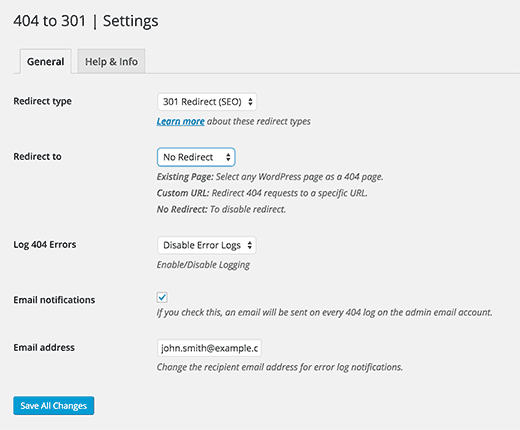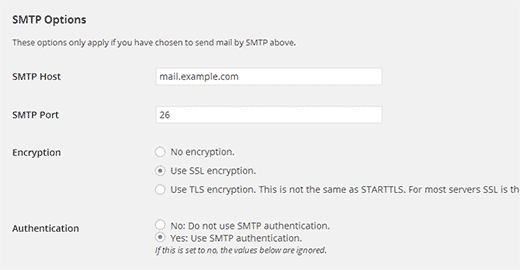404 errors are a cause of concern for many WordPress users. Particularly those who have just moved from WordPress.com to self hosted WordPress.org, or from one domain to another. These errors not only affect user experience on your site, they can also affect your site’s performance on search engines. In this article, we will show you how to get email alerts for 404 errors in WordPress.
First thing you need to do is install and activate the 404 t0 301 plugin. Upon activation, you need to go to 404 to 301 » 404 Settings to configure the plugin.
Select 301 Redirect as your redirect type. Select a page or a custom url in the redirect to field. You can also select not to redirect users to any page.
You can enable logging of 404 errors this way you can manually view logs if you need. Below that you need to check the email notifications checkbox and provide your email address. Don’t forget to click on the save changes button to store your settings.
To test the plugin, visit any non-existent page on your site (such as yoursite.com/lala404), and you will get an email notification of the 404 error in your inbox.
Troubleshooting 404 Email Alerts
Most common issue that you would come across when using this plugin is that it may not always deliver emails to your Gmail account. The reason for that is because this plugin uses the same email address in both To and From fields. Since the email is not originating from Gmail servers, Gmail considers this email spoofing and will automatically discard the message.
To solve this issue you can use Gmail SMTP server to send WordPress emails.
Another solution is to create an email account with your own domain name like wordpress@example.com. Most WordPress hosting providers allow you to create unlimited email accounts with your own domain name. Once you have created the email account, you need to find out its SMTP settings. Contact your web host to find out these settings. Bluehost users can find their email settings here.
After that you need to install and activate the WP Mail SMTP plugin and enter your SMTP settings.
We hope this article helped you set up email alerts for 404 errors on your WordPress site.
If you liked this article, then subscribe to our YouTube Channel for more WordPress video tutorials. You can also join us on Google+ and Twitter.







Syed Balkhi says
Hey WPBeginner readers,
Did you know you can win exciting prizes by commenting on WPBeginner?
Every month, our top blog commenters will win HUGE rewards, including premium WordPress plugin licenses and cash prizes.
You can get more details about the contest from here.
Start sharing your thoughts below to stand a chance to win!
Mrteesurez says
Nice one. So it is possible to receive an email notification whenever someone visits a 404 error page. I don’t know of this great feature. Thanks for sharing it. I will definitely check out the plugin and experience it.
Chynell says
I have dozens of 404 email notifications per day and no clue how to fix them all. Is it something that HAS to be fixed? Is it worth paying someone to fix?
WPBeginner Staff says
Noted your feedback, we will try to write about it soon.
KK says
Are there easy ways to remove 404 or not found pages from wp sites?
Justin Robinson says
404 errors are a much talked about point @ present & webmasters seem to be making lots of effort to jazz their 404 pages up.
This is a good area to touch & i notice that from hitting one on your site you have gone to town with relevant info to guide the user to other & relevant topics which is good.
What I would like to see if I may ask is a good tutorial guiding us through a good 404 error page setup.
Covering good to do’s & the ugly avoids.
Have you guys tackled this area yet?
Cheers,
Justin